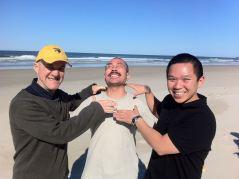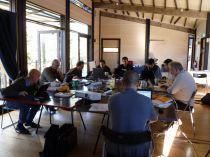
Barry Brook (left) and Lian Pin Koh (right) attacking Fangliang He (centre). © CJA Bradshaw
I’m sitting in the Brisbane airport contemplating how best to describe the last week. If you’ve been following my tweets, you’ll know that I’ve been sequestered in a room with 8 other academics trying to figure out the best ways to estimate the severity of the Anthropocene extinction crisis. Seems like a pretty straight forward task. We know biodiversity in general isn’t doing so well thanks to the 7 billion Homo sapiens on the planet (hence, the Anthropo prefix) - the question though is: how bad?
I blogged back in March that a group of us were awarded a fully funded series of workshops to address that question by the Australian Centre for Ecological Synthesis and Analysis (a Terrestrial Ecosystem Research Network facility based at the University of Queensland), and so I am essentially updating you on the progress of the first workshop.
Before I summarise our achievements (and achieve, we did), I just want to describe the venue. Instead of our standard, boring, windowless room in some non-descript building on campus, ACEAS Director, Associate Professor Alison Specht, had the brilliant idea of putting us out away from it all on a beautiful nature-conservation estate on the north coast of New South Wales.
What a beautiful place – Linneaus Estate is a 111-ha property just a few kilometres north of Lennox Head (about 30 minutes by car south of Byron Bay) whose mission is to provide a sustainable living area for (a very lucky few) while protecting and restoring some pretty amazing coastal habitat along an otherwise well-developed bit of Australian coastline. And yes, it’s named after Carl Linnaeus.

'The Crab', Linneaus Estate
But more than representing a refreshing change from the development carnage found just a bit to the north (the Gold Coast scar), it is also spectacularly beautiful. What a place to have a modelling workshop! We were housed in a building known as ‘the crab’ (because it superficially looks like one) within a noisy friarbird’s (Philemon corniculatus) cackle from the beach. With mobile wireless internet, a top-class kitchen from which chef Kate brought us goodies at all-too-often intervals, and the sound of the pounding surf and melodic cacophony of native birds wafting in through the open doors, we were in ecology-geek heaven. Did I mention that the sun shone the entire week? I bet you’re saying to yourself right now – you jammy bastards.
Yes. Yes, we are.
Right. To the science. For a complete synopsis of what we were aiming to achieve, do read the previous post, but here’s a brief list of our achievements during Workshop One:
- Our first major achievement was the development of a spatial community simulation to examine various assumptions underlying species-area relationships (SAR). Fangliang He developed the code to simulate landscapes populated by many species following various abundance patterns and aggregation coefficients; Barry Brook developed the sampling code to construct SAR and endemic species-area relationships (EAR), incorporating aspects of extinction debt; and I developed a spatial habitat-destroying routine that constructs harvest patch distributions from completely random to highly clumped (based on the negative binomial distribution). We haven’t yet put it all together, but most of the base code is written. If you’ve been following the minor dust-up in the ecological literature about SAR, you’ll understand why the first photo above is funny.
- Lian Pin Koh, Stephen Gregory, Xingli Giam and Cagan Sekercioglu worked feverishly on constructing biogeographical realm- and Hotspot-scale SAR for birds and mammals at a global scale. Lian Pin and Tien Ming Lee have put together a series of land-use projections (incorporating deforestation trends and climate change expectations) and we will combine these with the global-scale SARs to estimate extinction rates in these taxa.
- Nigel Stork focussed on putting together papers and datasets looking at relaxation times (extinction debt) for various taxa. Our goal here is to put together a meta-analytical paper on relaxation times.

Working hard on the extinction rate estimation problem
- Damien Fordham, Stephen Gregory and I focussed on constructing SAR for coral reef fish on the Great Barrier Reef using species richness and abundance predictions we published last year (see relevant papers by Camille Mellin and colleagues here and here). We’ll be projecting coral bleaching events using combined global circulation model predictions of sea surface temperatures, and predicting reef fish species loss based on the extent of predicted bleaching.
- Finally, Fangliang He and Cagan Sekercioglu worked on putting together bird range-loss data to estimate population size reductions based on a model Fangliang developed.
In short, we accomplished a lot in one week. The challenge will be to see these analyses to fruition (publication); luckily, we have another workshop scheduled at the same place in early November where we will likely tie up any loose ends and add fresh datasets. Many group members who couldn’t make it this time (Tien Ming Lee, Mark Burgman, Andy Lowe, Chris Johnson, Bill Laurance and Steve Williams) will hopefully be able to attend the second workshop.
I’d also like to point out that Navjot Sodhi was scheduled to participate in these workshops, but as most of you already know, he died suddenly last month. We dedicated our work to his memory.
I’ll make sure I report on our progress as analyses are completed and published. Thanks to my fellow group members for making it a great and productive experience, to Alison Specht for her incredible organisational skills, efficiency, generosity and good nature, to the rest of the ACEAS organisational team, to Linnaeus Estate for providing the best workshop venue I’ve ever experienced, and to the Australian Bureau of Meteorology who scheduled the marvellous winter weather.
CJA Bradshaw

